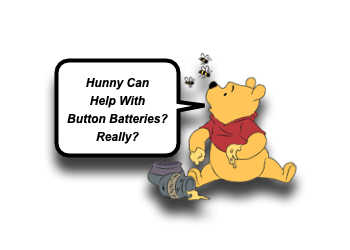Neutralize Button Battery in the Esophagus

Last week was a highly productive week for my educational enlightenment. I learned that not all Compartment Syndrome is Acute… it can be Chronic as well. I also learned that there is a cross over between the application of Honey and Esophageal Button Battery Foreign Bodies. Fortunately, I work with some amazingly brilliant physicians… so I get to learn from them pretty often. This time, Dr. Christine Murphy (the director of the Medical Toxicology Fellowship at CMC) introduced me to how we can help reduce the risk of esophageal injury from Button Batteries. So let’s take a few minutes to digest the application of honey as a means to Neutralize Button Battery in the Esophagus:
Esophageal Button Battery
- There has been a significant increase in battery-related ED visits and an increased morbidity and mortality from them! [Jatana, 2019]
- Tissue damage from Button Battery is due to isothermal hydrolysis reaction and alkaline caustic exposure. [Jatana, 2019]
- Recall, aLkaLine caustics lead to Liquefaction necrosis.
- When the battery is placed in a moist environment (ex, mucous membranes, saliva), an electrical charge is generated.
- The Lithium Button Batteries have twice the capacitance of other button batteries (3 volts vs 1.5 volts).
- Lithium Button Batteries can generate more current and have been associated with worse outcomes.
- Even old, used (spent) Lithium Button Batteries can still generate enough current to damage tissue!
- The discharged current hydrolyzes water, generating Hydoxide ions — leading to alkaline injury.
- Complications from Esophageal Foreign Bodies – caustic tissue damage leads to local structure damage:
- Perforations
- Fistulas
- Tracheoesophageal Fistula
- Fistulation of major blood vessels
- Vocal cord damage and paralysis
- Strictures
- Spondylodiscitis
- Massive Hemorrhage
- Death
Neutralize Button Battery in the Esophagus
- Issues to consider: [Jatana, 2019]
- Damage starts early after exposure (in as little as 2 hours)
- Continued exposure leads to greater risk and damage.
- Liquefaction necrosis / injury does not stop immediately once Button Battery is removed.
- Complications can present in a delayed fashion (even up to 9 days to even weeks later).
- Reduce early injury:
- Obviously, it is advantageous to reduce the impact of the caustic injury before it occurs.
- The challenge:
- Some children with an esophageal foreign body will not tolerate oral therapies.
- Some oral therapies could contradict “NPO status guidelines” for your hospital.
- Although the risk of caustic injury greatly outweighs the very remote risk of inducing emesis/aspiration.
- Several options have been tried in vitro and in vivo models and two have been found to improve outcomes: [Arfang, 2019]
- Honey – 10 mL (2 teaspoons) every 10 minutes (no real known preferred amount)
- Pros: palatable, viscous, and a weak acid… plus available at home!
- Cons: caution if dealing with a child < 1 year of age due to risk for botulism.
- Carafate – 10 mL (2 teaspoons) every 10 minutes (no real known preferred amount)
- Pros: can be cherry-flavored and forms paste-like material to be a barrier
- Cons: not typically in a family’s house (but can be used once in ED), may obscure the extent of the damage due to white residue, impacting visualization of the mucosa. [Costello, 2019]
- Honey – 10 mL (2 teaspoons) every 10 minutes (no real known preferred amount)
- Use of these therapies does NOT negate the need to remove the Button Battery in an expeditious fashion! [Renny, 2019]
- Remove the Button Battery expeditiously!
- Obviously, no amount of honey (or carafate) is going to reverse the problem.
- Consult your team (for my group it is Pediatric Surgery) to coordinate removal of this particularly foreign body expeditiously… time is critically important.
- Neutralize the alkaline exposure… even after the battery is removed. [Jatana, 2019]
- A weak acid can safely and effectively reduce the potential for continued liquefaction necrosis after the button battery has been removed.
- Prior theories about the potential thermal injury from the neutralization process have not been found to occur in vivo models.
- Possible that the large water component helps to offset the released heat.
- 0.25% Acetic Acid, 50 – 150 mL used to irrigate the region in the operating room can help improve outcomes.
- Irrigation occurs during the rigid bronchoscopy after the battery has been removed.
- The excess fluid is suctioned simultaneously during irrigation.
- Not all providers may know of the utility of acetic acid irrigation so be sure to bring it up to help ensure optimal management.
- Contacting Poison Control (1-800-222-1222) may help ensure optimal care too!
- A weak acid can safely and effectively reduce the potential for continued liquefaction necrosis after the button battery has been removed.
Moral of the Morsel
- Button Batteries are Bad when next to Mucosa. Simple statement, but true.
- Honey is pretty amazing. While the definitive literature is still being debated, the risk – benefit ratio of giving honey in setting of esophageal button battery would currently favor administration!
- Liquefaction keeps being a problem! Removing the battery is imperative, but the caustic injury continues after the battery is gone, so neutralize it!

